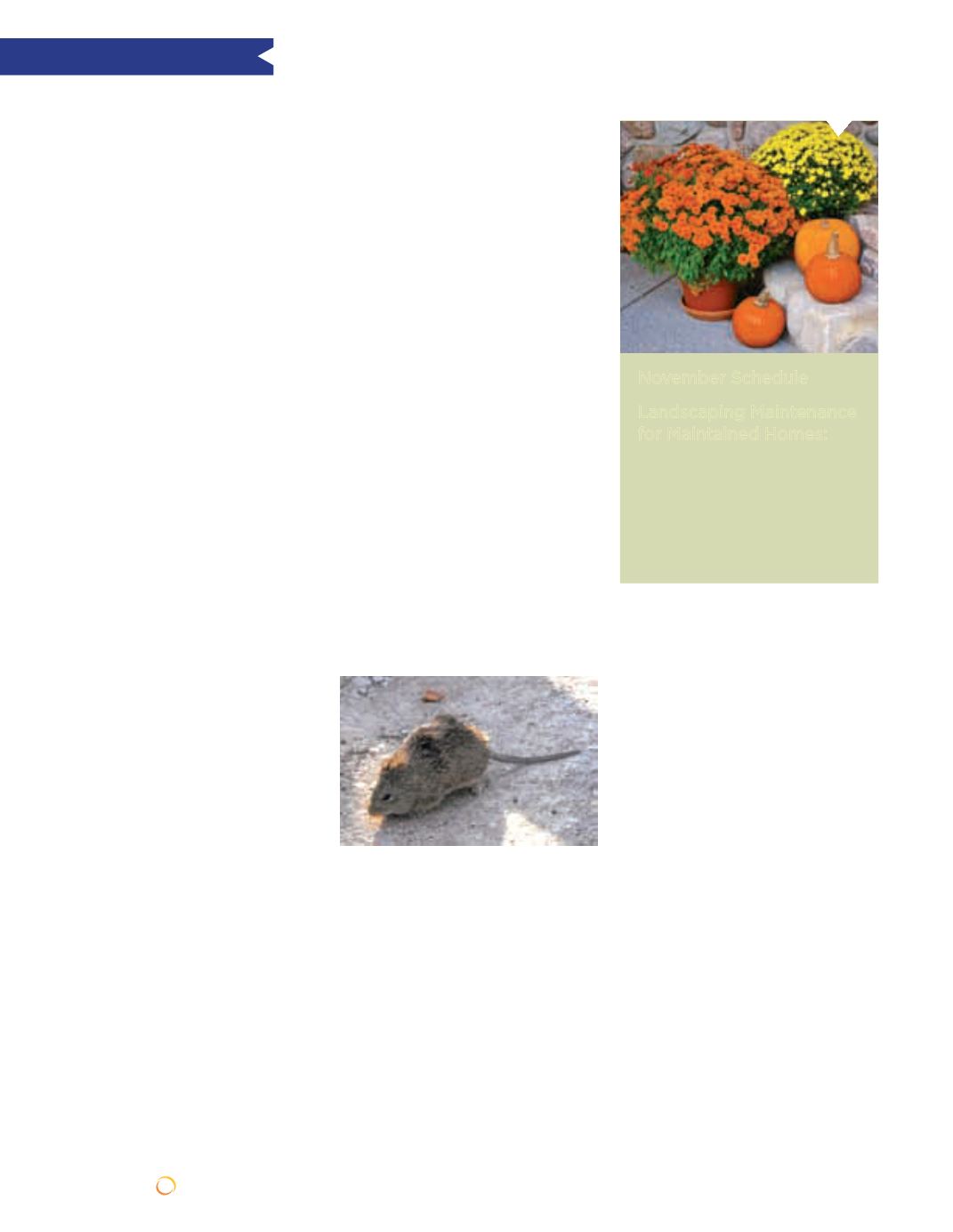
10 | SUNRAYS
NOVEMBER 2013
ONLINE:
SCTXCA.ORG
CA NEWS
The hispid cotton rat, often mistaken
for the Norway or brown rat, is usually
seen in Sun City Texas after the mow-
ing of common areas, which disrupts or
destroys their habitat.
DESCRIPTION
The cotton rat is moderately large with a
scaly, sparsely haired tail. Distinguish-
ing characteristics are the rough, griz-
zled appearance of blackish, brownish,
or grayish back fur and grayish-white
or buff underside. The animal’s total
length averages 10 inches, including a
tail length of four inches. The cotton rat
may be distinguished from the Norway
rat by its smaller size, shorter tail, and
longer grizzled fur.
HABITAT
Cotton rats prefer dense cover such as
grassy fields, overgrown roadsides, or
fencerow vegetation. Under protective
cover, the rats have well-defined runways
radiating from their nest sites usually
located in underground chambers or in
dense clumps of grass or piles of brush
above ground.
The rats are normally herbivores, eating
the roots, stems, leaves and seeds of a
wide variety of plants. They also feed
on fruits, nuts, insects, the eggs/young
of ground-nesting birds, and animal
carcasses.
BEHAVIOR
Cotton rats are active year-round and
are typically nocturnal, but they will
venture out in the day. They are very
prolific; several litters may be produced
annually, averaging 2-15 per litter. The
gestation period is 27 days, and young
are weaned in 10-15 days. Most cot-
ton rats begin breeding at two to three
months of age, while their average life-
span is about six months.
CONTROL ECONOMICS
Cotton rats rarely invade houses; if they
do, it is the result of damage or destruc-
tion of their habitat; their instinct is to
return to their nests as soon as possible.
Control measures for cotton rats are lim-
ited, and include the following:
• Exclusion:
Sheet metal barriers are
usually not practical.
• Cultural Methods:
Removal of
dense cover by burning, mowing,
plowing, or the use of herbicides
can reduce habitat and prevent large
population increases.
• Repellents:
None are registered (or
listed) for effectively repelling cot-
ton rats.
• Fumigants:
Not very practical be-
cause of infrequent use of their tun-
nels and burrows.
• Trapping:
Small rodent live traps
or rat-sized snap traps are effective.
Current Issues in Wildlife Management – Cotton Rats
Submitted by the Wildlife Management Committee
With the election less than a week away,
now is the time for a reminder that signs
for the November 5 election need to be
removed by November 15. We appreciate
the good will and tolerance displayed
throughout this election season.
As you remove political signs and plan
for holiday decorations, take a look
around your yard and see if there are
any dead or dying plants that need to
be replaced or removed. Maintenance
of established beds does not require an
application for modifications, so feel free
to change out turf, add mulch, and re-
place plants, groundcover and shrubs
as necessary. If you do want to expand
one of the beds or change out mulch to
river rock or decomposed granite, then
we will need an application for modifica-
tions (B-1 Form) to be filled out.
When completing an application for land-
scape modification, we recently developed
a worksheet for landscape modifications
that may be helpful. If you would like a
B-1 Form, a plot plan to use for sketch-
ing proposed changes, or a copy of the
new worksheet, you can email our office
at communitystandardsoffice@sctexas.
org, and provide either your home ad-
dress or membership number, and we’ll
be happy to reply with the forms to help
you complete the process. Of course, you
can always come by the office and pick
up printed copies of any of the forms we
require.
Finally, November 15 heralds the start
of our holiday season. Decorations may
be displayed through January 15. This
is the time to decorate mailboxes, hang
lights on houses, and add displays in the
yard that are appropriate to the season.
Have a lovely Thanksgiving!
Bits of Info from ginny’s Desk
Submitted by Ginny Wagner, Community Standards Supervisor
November Schedule
Landscaping Maintenance
for Maintained Homes:
• One Visit for Cut, Edge and Trim
• Monthly Irrigation Check
• Shrub Pruning
• Weeding of Bed Areas
• Insect & Disease Monitoring


